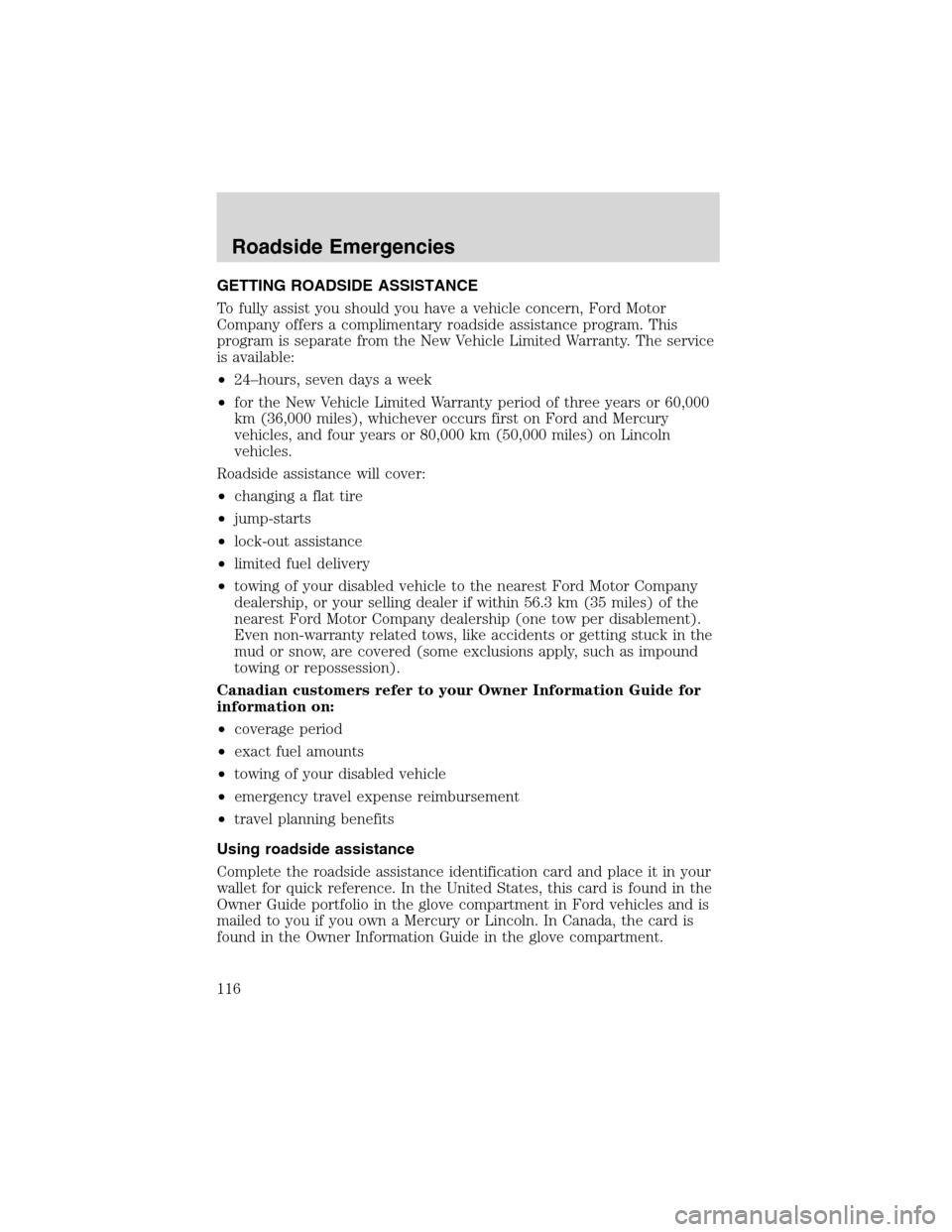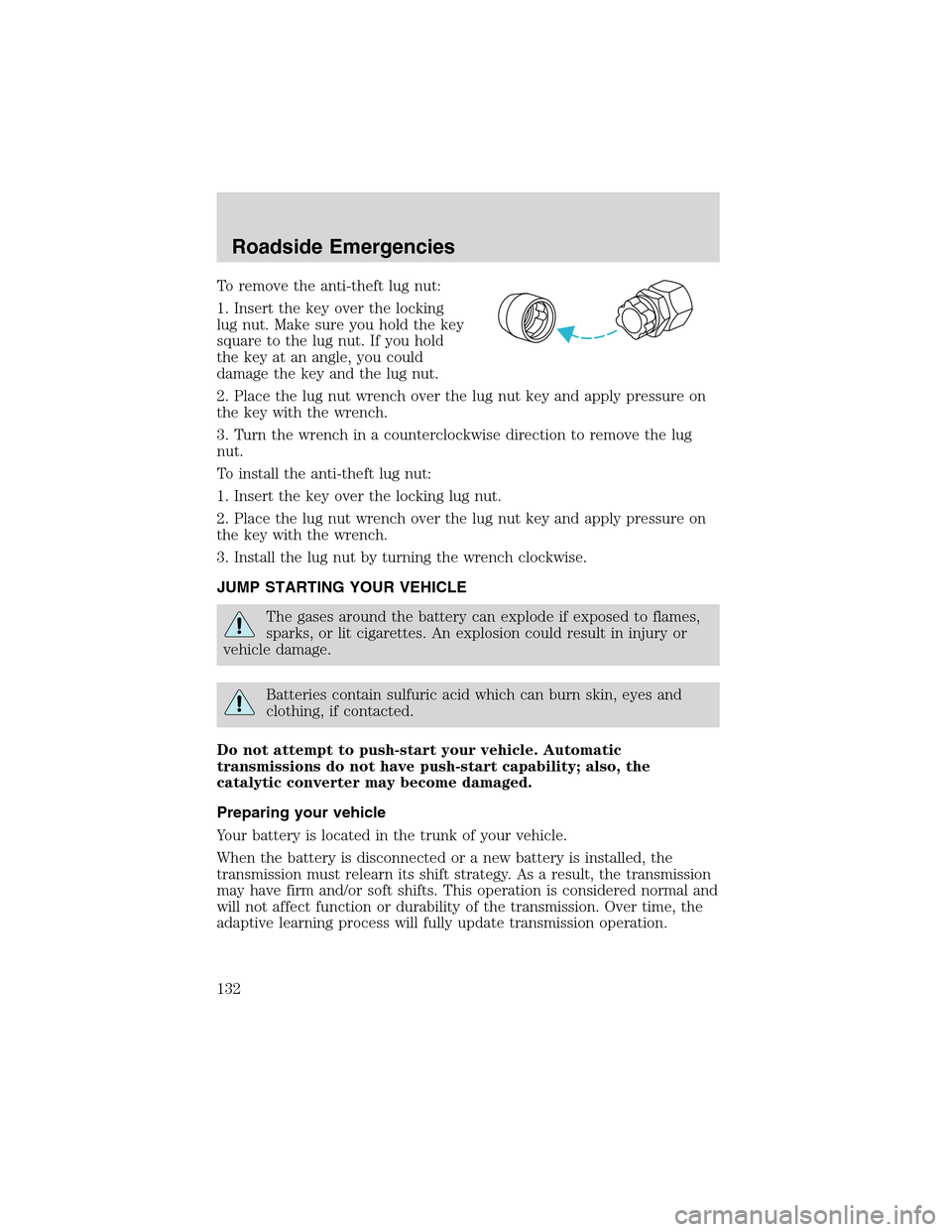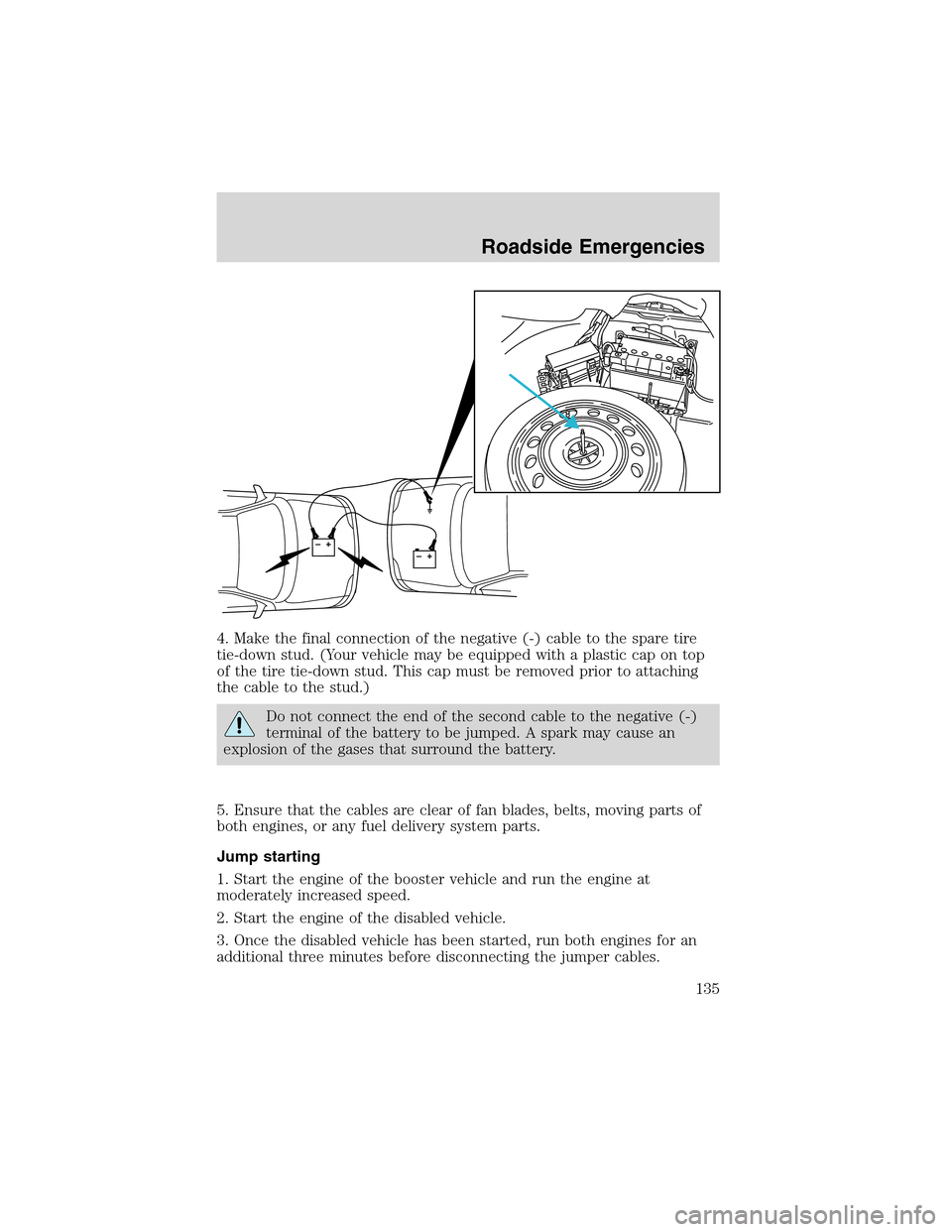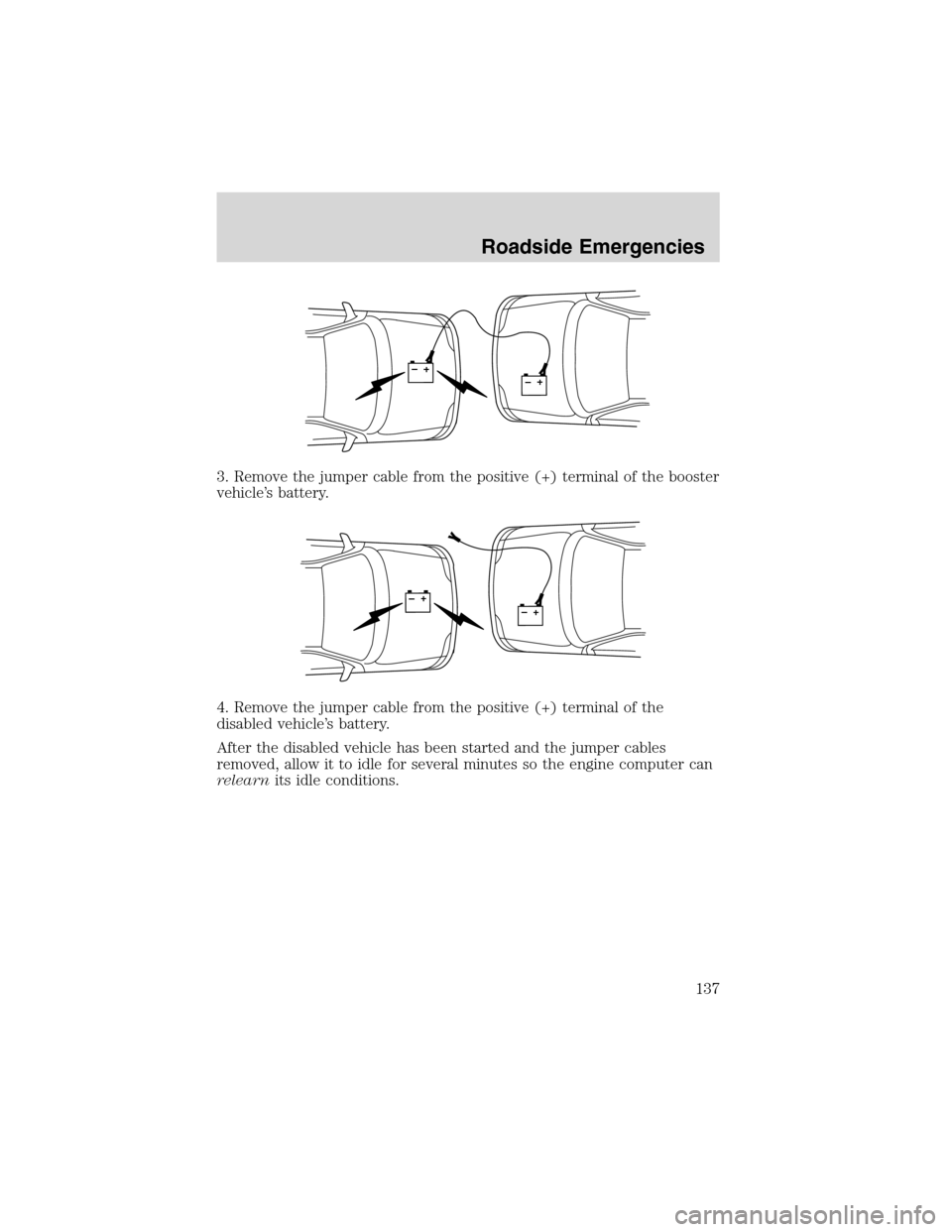2003 FORD THUNDERBIRD jump start
[x] Cancel search: jump startPage 2 of 200

Brakes 105
Traction control/AdvanceTrac 106
Transmission operation 108
Trailer towing 115
Roadside Emergencies 116
Getting roadside assistance 116
Hazard flasher switch 117
Fuel pump shut-off switch 118
Fuses and relays 118
Changing tires 127
Jump starting 132
Wrecker towing 138
Customer Assistance 139
Reporting safety defects (U.S. only) 147
Cleaning 148
Maintenance and Specifications 154
Engine compartment 155
Engine oil 156
Battery 159
Fuel information 167
Air filter(s) 178
Part numbers 182
Refill capacities 183
Lubricant specifications 184
Accessories 189
Index 191
All rights reserved. Reproduction by any means, electronic or mechanical
including photocopying, recording or by any information storage and retrieval
system or translation in whole or part is not permitted without written
authorization from Ford Motor Company. Ford may change the contents without
notice and without incurring obligation.
Copyright © 2002 Ford Motor Company
Table of Contents
2
Page 116 of 200

GETTING ROADSIDE ASSISTANCE
To fully assist you should you have a vehicle concern, Ford Motor
Company offers a complimentary roadside assistance program. This
program is separate from the New Vehicle Limited Warranty. The service
is available:
•24–hours, seven days a week
•for the New Vehicle Limited Warranty period of three years or 60,000
km (36,000 miles), whichever occurs first on Ford and Mercury
vehicles, and four years or 80,000 km (50,000 miles) on Lincoln
vehicles.
Roadside assistance will cover:
•changing a flat tire
•jump-starts
•lock-out assistance
•limited fuel delivery
•towing of your disabled vehicle to the nearest Ford Motor Company
dealership, or your selling dealer if within 56.3 km (35 miles) of the
nearest Ford Motor Company dealership (one tow per disablement).
Even non-warranty related tows, like accidents or getting stuck in the
mud or snow, are covered (some exclusions apply, such as impound
towing or repossession).
Canadian customers refer to your Owner Information Guide for
information on:
•coverage period
•exact fuel amounts
•towing of your disabled vehicle
•emergency travel expense reimbursement
•travel planning benefits
Using roadside assistance
Complete the roadside assistance identification card and place it in your
wallet for quick reference. In the United States, this card is found in the
Owner Guide portfolio in the glove compartment in Ford vehicles and is
mailed to you if you own a Mercury or Lincoln. In Canada, the card is
found in the Owner Information Guide in the glove compartment.
Roadside Emergencies
116
Page 132 of 200

To remove the anti-theft lug nut:
1. Insert the key over the locking
lug nut. Make sure you hold the key
square to the lug nut. If you hold
the key at an angle, you could
damage the key and the lug nut.
2. Place the lug nut wrench over the lug nut key and apply pressure on
the key with the wrench.
3. Turn the wrench in a counterclockwise direction to remove the lug
nut.
To install the anti-theft lug nut:
1. Insert the key over the locking lug nut.
2. Place the lug nut wrench over the lug nut key and apply pressure on
the key with the wrench.
3. Install the lug nut by turning the wrench clockwise.
JUMP STARTING YOUR VEHICLE
The gases around the battery can explode if exposed to flames,
sparks, or lit cigarettes. An explosion could result in injury or
vehicle damage.
Batteries contain sulfuric acid which can burn skin, eyes and
clothing, if contacted.
Do not attempt to push-start your vehicle. Automatic
transmissions do not have push-start capability; also, the
catalytic converter may become damaged.
Preparing your vehicle
Your battery is located in the trunk of your vehicle.
When the battery is disconnected or a new battery is installed, the
transmission must relearn its shift strategy. As a result, the transmission
may have firm and/or soft shifts. This operation is considered normal and
will not affect function or durability of the transmission. Over time, the
adaptive learning process will fully update transmission operation.
Roadside Emergencies
132
Page 133 of 200

1.Useonly a 12–volt supply to start your vehicle.
2. Do not disconnect the battery of your disabled vehicle as this could
damage the vehicle’s electrical system. Keep the battery vent hose
attached at all times.
3. Park the booster vehicle close to the trunk of your disabled vehicle
making sure the two vehiclesdo nottouch. Set the parking brake on
both vehicles and stay clear of the engine cooling fan and other moving
parts.
4. Check all battery terminals and remove any excessive corrosion before
you attach the battery cables. Ensure the vent caps are tight and level.
5. Turn the heater fan on in both vehicles to protect any electrical
surges. Turn all other accessories off.
Connecting the jumper cables
1. Connect the positive (+) booster cable to the positive (+) terminal of
the discharged battery.
Note:In the illustrations,lightning boltsare used to designate the
assisting (boosting) battery.
+–+–
Roadside Emergencies
133
Page 135 of 200

4. Make the final connection of the negative (-) cable to the spare tire
tie-down stud. (Your vehicle may be equipped with a plastic cap on top
of the tire tie-down stud. This cap must be removed prior to attaching
the cable to the stud.)
Do not connect the end of the second cable to the negative (-)
terminal of the battery to be jumped. A spark may cause an
explosion of the gases that surround the battery.
5. Ensure that the cables are clear of fan blades, belts, moving parts of
both engines, or any fuel delivery system parts.
Jump starting
1. Start the engine of the booster vehicle and run the engine at
moderately increased speed.
2. Start the engine of the disabled vehicle.
3. Once the disabled vehicle has been started, run both engines for an
additional three minutes before disconnecting the jumper cables.
+–+–
Roadside Emergencies
135
Page 137 of 200

3. Remove the jumper cable from the positive (+) terminal of the booster
vehicle’s battery.
4. Remove the jumper cable from the positive (+) terminal of the
disabled vehicle’s battery.
After the disabled vehicle has been started and the jumper cables
removed, allow it to idle for several minutes so the engine computer can
relearnits idle conditions.
+–+–
+–+–
Roadside Emergencies
137
Page 192 of 200

waxing.....................................148
wheels ......................................149
wiper blades ............................150
Climate control (see Air
conditioning or Heating) ............19
Console ........................................54
Controls
power seat .................................68
steering column ........................42
Convertible ..................................43
cleaning .............................47, 151
installation of the boot .............44
lowering the convertible top ...43
raising the convertible top ......45
Coolant
checking and adding ..............161
refill capacities ................165, 183
specifications ..................184, 186
Cruise control
(see Speed control) ....................39
Customer Assistance ................116
Ford accessories for your
vehicle .....................................153
Ford Extended Service
Plan ..........................................141
Getting assistance outside the
U.S. and Canada .....................145
Getting roadside assistance ...116
Getting the service you
need .........................................139
Ordering additional owner’s
literature .................................146
The Dispute Settlement
Board .......................................142
Utilizing the
Mediation/Arbitration
Program ...................................144D
Daytime running lamps
(see Lamps) ................................25
Defrost
rear window ..............................22
Dipstick
automatic transmission
fluid ..........................................177
engine oil .................................156
Doors
lubricant specifications ..........184
Driving under special
conditions ..................................113
through water .........................113
E
Emergencies, roadside
jump-starting ..........................132
Emission control system ..........174
Engine ........................................186
cleaning ...................................149
coolant .....................................161
fail-safe coolant ......................165
idle speed control ...................159
lubrication specifications ......184,
186
refill capacities ........................183
service points ..........................155
Engine block heater .................104
Engine oil ..................................156
checking and adding ..............156
dipstick ....................................156
filter, specifications ........158, 182
recommendations ...................158
refill capacities ........................183
specifications ..................184, 186
Exhaust fumes ..........................105
Index
192
Page 193 of 200

F
Fail safe cooling ........................165
Floor mats ...................................54
Fluid capacities .........................183
Fuel ............................................167
calculating fuel economy .......171
cap ...........................................169
capacity ...................................183
choosing the right fuel ...........169
comparisons with EPA fuel
economy estimates .................174
detergent in fuel .....................170
filling your vehicle with
fuel ...........................167, 169, 171
filter, specifications ........171, 182
improving fuel economy ........171
octane rating ...................170, 186
quality ......................................170
running out of fuel .................171
safety information relating to
automotive fuels .....................167
Fuses ..................................118–119
G
Gas cap (see Fuel cap) ............169
Gas mileage (see Fuel
economy) ...................................171
Gauges .........................................12
GAWR (Gross Axle Weight
Rating) .......................................114
definition .................................114
driving with a heavy load ......114
location ....................................114
GVWR (Gross Vehicle Weight
Rating) .......................................114
calculating ...............................114
definition .................................114
driving with a heavy load ......114location ....................................114
H
Head restraints ...........................66
Headlamps ...................................24
aiming ........................................26
autolamp system
.......................24
bulb specifications
....................28
daytime running lights
.............25
flash to pass
..............................25
replacing bulbs
.........................29
turning on and off
....................24
Heating
heating and air conditioning
system
.......................................19
Hood
..........................................155
I
Ignition
...............................102, 186
Infant seats (see Safety seats)
..94
Inspection/maintenance (I/M)
testing
........................................175
Instrument panel
cleaning
...................................151
cluster
..........................................8
lighting up panel and
interior
.......................................26
J
Jack
............................................127
positioning
...............................127
storage
.....................................127
Jump-starting your vehicle
......132
Index
193